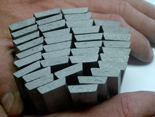Fiberglass Epoxy Sheets
About Fiberglass Epoxy Sheets
Insulated Fiberglass Epoxy Sheets
In each slot of an a-c motor or generator stator, a strip of insulating material is fitted into lamination grooves to wedge the coils tightly in place. Although such a "slot wedge" need not exhibit high dielectric strength, it must withstand the electromagnetic force tending to push coils out of the slot. (In a wound rotor or armature, centrifugal force acts in the same direction.)
Although precise calculation of the cyclic forces acting on a stator slot wedge is not feasible, even conservative estimates are far below material stress limits. However, the fit between lamination grooves and the edges of a wedge is neither uniform nor exactly predictable, and is subject to wear during service. Wedge looseness is therefore a major concern in large machines not subject to global impregnation. Periodic testing of wedge tightness is essential in large generator maintenance.
Because the extension of the wedge into its supporting grooves necessarily blocks off part of the air space on either side of the coils at each vent space in the core, wedges are often notched out at those spaces to remove that restriction. An alternative (unacceptable to some users) is to place only a few short wedges in each slot, counting on VPI treatment to bond the coils in place. Other special machining of wedge contours has been used to better direct ventilating air flow from the rotor into the passages between stator coils.


Price:
- 50
- 100
- 200
- 250
- 500
- 1000+
More Products in Epoxy Laminates Category
Fibreglass Epoxy Laminated Sheets
Price Range 300.00 - 500.00 INR / Kilograms
Minimum Order Quantity : 100 Meters
Shape : Flat rectangular sheet.
Thickness : Available from 0.2 mm to 100 mm.
Density : 2.0 Gram per cubic centimeter(g/cm3)
Dimension (L*W*H) : 1220 mm x 1020 mm x 0.5 mm to 100 mm (custom sizes available).

 Send Inquiry
Send Inquiry



 English
English Spanish
Spanish French
French German
German Italian
Italian Chinese (Simplified)
Chinese (Simplified) Japanese
Japanese Korean
Korean Arabic
Arabic Portuguese
Portuguese